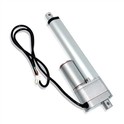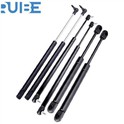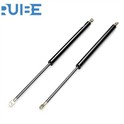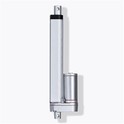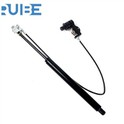When it comes to using gas springs, safety is of utmost importance. As a gas spring supplier, I've witnessed firsthand the impact that proper safety precautions can have on both the longevity of the product and the well - being of the users. In this blog, I'll delve into the essential safety measures that should be taken when using gas springs.
Understanding Gas Springs
Before we jump into safety precautions, let's briefly understand what gas springs are. Gas springs are mechanical components that use compressed gas (usually nitrogen) to provide force. They are commonly used in various applications, such as Gas Spring for Furniture, Gas Spring for Car, and Gas Spring for Kitchen Cabinet. Their ability to provide smooth and controlled motion makes them a popular choice in many industries.
Pre - installation Safety Precautions
1. Correct Selection
The first step in ensuring safety is to select the right gas spring for the application. Each application has specific requirements in terms of force, stroke length, and mounting style. For example, a gas spring used in a car hood needs to have sufficient force to lift the heavy hood smoothly, while a gas spring for a kitchen cabinet may require a lower force but a more precise stroke length. Incorrect selection can lead to overloading, which may cause the gas spring to fail prematurely or even pose a safety hazard.
2. Inspection
Before installation, carefully inspect the gas spring for any visible damage, such as dents, scratches, or leaks. A damaged gas spring may not function properly and could potentially cause injury. Check the seals and the body of the gas spring to ensure they are in good condition. If any damage is detected, do not use the gas spring and contact the supplier for a replacement.
3. Mounting
Proper mounting is crucial for the safe operation of gas springs. Follow the manufacturer's instructions carefully when mounting the gas spring. Ensure that the mounting points are strong enough to withstand the forces exerted by the gas spring. Incorrect mounting can cause the gas spring to come loose during operation, leading to unexpected movement or even detachment.
During - use Safety Precautions
1. Avoid Overloading
One of the most common causes of gas spring failure is overloading. Do not exceed the maximum load capacity specified by the manufacturer. Overloading can cause the gas spring to lose its pressure, resulting in reduced performance or even failure. If the application requires more force than the gas spring can provide, consider using a higher - capacity gas spring or multiple gas springs.
2. Keep Clear of Moving Parts
When the gas spring is in operation, keep hands, fingers, and other body parts clear of the moving parts. Gas springs can move quickly and with significant force, which can cause serious injury if a body part gets caught. In applications where there is a risk of contact with moving parts, consider using guards or shields.
3. Regular Maintenance
Regular maintenance is essential for the safe and efficient operation of gas springs. Periodically check the gas spring for signs of wear and tear, such as leaks or reduced performance. Lubricate the moving parts as recommended by the manufacturer to ensure smooth operation. If any problems are detected during maintenance, address them immediately.
Post - use Safety Precautions
1. Proper Storage
When the gas spring is not in use, store it properly. Keep it in a dry, clean place away from direct sunlight and extreme temperatures. High temperatures can cause the gas inside the spring to expand, while low temperatures can cause it to contract, which may affect the performance of the gas spring.
2. Disposal
When a gas spring reaches the end of its useful life, it must be disposed of properly. Gas springs contain compressed gas, so they should not be punctured or incinerated. Contact a professional waste disposal service that is experienced in handling gas springs to ensure safe disposal.
Safety Precautions for Different Applications
1. Furniture
In furniture applications, such as chairs and beds, gas springs are often used to provide adjustable support. When using gas springs in furniture, ensure that the furniture is stable and that the gas spring is properly installed. Avoid sudden or excessive movements that could cause the gas spring to malfunction.
2. Cars
Gas springs in cars are commonly used for hoods, trunks, and tailgates. In addition to the general safety precautions, it's important to ensure that the gas springs are compatible with the car's make and model. Also, be aware that the gas springs in cars are exposed to harsh environmental conditions, so regular inspection and maintenance are even more critical.
3. Kitchen Cabinets
For kitchen cabinets, gas springs are used to provide smooth opening and closing. Make sure that the cabinet doors are properly balanced and that the gas springs are adjusted correctly. This will prevent the doors from slamming shut or opening too forcefully, reducing the risk of damage and injury.
Safety Precautions for Special Situations
1. High - temperature Environments
In high - temperature environments, the gas inside the gas spring may expand, increasing the pressure. This can cause the gas spring to overheat and potentially fail. If the gas spring is used in a high - temperature environment, choose a gas spring that is designed to withstand high temperatures. Additionally, provide proper ventilation to keep the gas spring cool.


2. Low - temperature Environments
In low - temperature environments, the gas inside the gas spring may contract, reducing the force. This can cause the gas spring to operate sluggishly or not at all. If the gas spring is used in a low - temperature environment, select a gas spring that is suitable for cold temperatures. Insulating the gas spring can also help maintain its performance.
Conclusion
In conclusion, using gas springs safely requires careful attention to pre - installation, during - use, and post - use safety precautions. By following these guidelines, you can ensure the safe and efficient operation of gas springs in various applications. As a gas spring supplier, I am committed to providing high - quality products and accurate information to help our customers use gas springs safely. If you have any questions about gas spring safety or are interested in purchasing gas springs for your specific application, please feel free to contact us for more information and to start a procurement discussion.
References
- Manufacturer's manuals for gas springs
- Industry standards and guidelines for gas spring use
- Technical papers on gas spring design and safety

